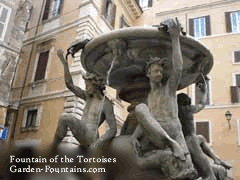 To explain this concept of art versus architecture it is prudent to look at a few roman fountains. The fountain at the Pantheon, for example, adds architectural value to the area, making it prevail in value even if there was no water flowing through it. When looking at the fountain in Piazza Ara Coeli, the lack of water ruins the spell cast by the fountain. The reason is that the container and content were meant to work together. So did Jacopo della Porta succeed in the creation the Fountain of the Tortoises? The first impression of the fountain is amazing, but as you move closer the impression changes as you can see the discord and disproportion of the fountain.
To explain this concept of art versus architecture it is prudent to look at a few roman fountains. The fountain at the Pantheon, for example, adds architectural value to the area, making it prevail in value even if there was no water flowing through it. When looking at the fountain in Piazza Ara Coeli, the lack of water ruins the spell cast by the fountain. The reason is that the container and content were meant to work together. So did Jacopo della Porta succeed in the creation the Fountain of the Tortoises? The first impression of the fountain is amazing, but as you move closer the impression changes as you can see the discord and disproportion of the fountain.
The problem is the bad integration of ideas and designs, in the effort to create a harmony between container and content. There is a lack of continuity, best seen in the material used. The base was in poryphyry, the shells are portsana, and the case is African marble. The shells are far too large in proportion to the fountain, creating a heavy appearance when compared to the slender ephebes. The same concept is applied to center pedestal vase, which is huge in comparison to the tiny cherubs above the water.
One of the most positive aspects of the fountain, which makes the fountain popular, is that the ephebes feature lively and exciting character. The ephebes try to hold onto a dolphin, while holding up a tortoise to help it drink. The Tortoises were actually added during a restoration, ordered by Alexander VIII in 1658, and were not an original part of the fountain.
It was Bernini who inspired the addition of the Tortoises. Inspired by Bernini’s Barberini fountain, the tortoises were placed where they were because the youth’s hands seem to be pushing up towards the turtles. So before the addition of the tortoises, it would have astonished onlookers that the hands were so far away from the upper basin, furthermore the positioning of the youths were all the same, perhaps a greeting to the tourist? The actual answer comes from the writing of Jacopo himself, who has eight fish ordered for the fountain, but only four of the bronze fish are placed under the foot of the youth on the fountain, meaning that most likely the other four were to go over the hands of the youths, but were too heavy to be supported, and therefore unused.
